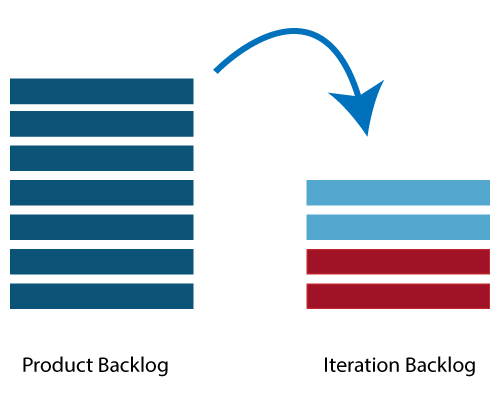The primary purpose of iteration planning is for the team. The team should be a complete set of the top-ranked product backlog items. The completion of top ranked product backlog is a commitment in the time needed on the length of iteration and team velocity.

Who involved in the iteration planning?
Scrum Master: The Scrum Master is a team leader and facility provider. He helps the team member to follow agile practices so that they can meet their commitments and customers requirements.
Product Owner: The Product Owner deals with a complete view of the product backlog and their acceptance criteria.
Agile Development Team: Agile delivery defines their tasks and sets the effort. The effort is to estimate the requirements to fulfill the commitment.
Prerequisites of Planning
- The items in the product backlog are sized and have a relative story point assigned.
- The product owner gave the ranking to the portfolio items.
- Acceptance criteria of each portfolio item is clearly stated.
Planning Process
Iteration planning involved the following steps:
- Determines how many requirements (stories) are fit in an iteration.
- Break this requirement into tasks. Assign each task to their owners.
- Each task is set to some estimated time.
- These estimates help the team members to check how many hours for each member will be required to iterate.
- Team members are assigned tasks by seeing their velocity or capacity. Due to this, the team member is not overburdened.
Velocity Calculation
The agile team calculates the velocity based on the previous iterations. A velocity is an average number of units that required finishing user stories in the iteration. Assume that, a team took 10,12,8 story points in each iteration for the previous three iterations, this shows that the team can take 10 as velocity for the next iteration.
Planned velocity tells the team how many user requirements can be completed in the current iteration. If the team instantly finishes the work assigned, then more user requirements can be pulled in. Otherwise, the requirement can be moved out too to the next iteration.
Task capacity
Three factors determine the capacity of the team:
- Total number of ideal working hours in a day
- A person gives total days in each iteration
- Percentage of time a member is entirely available for the team.
Considered a team has 6 members, committed to work full time of 8 hours a day on a project. And no member is on leave during iteration, and then the task capacity for two-week iteration will be-
6 x 8 x 10 = 480 hours
Iteration Planning Steps
- Product Owner describes the highest ranked item of the product backlog.
- Team member describes the tasks required to complete the item.
- Team members own the tasks.
- The team member estimates their own time to finish each task.
- The above steps are repeated for all the items in the iteration.
- If any member is overloaded with work, then his/her tasks distributed among other team members.



0 Comments